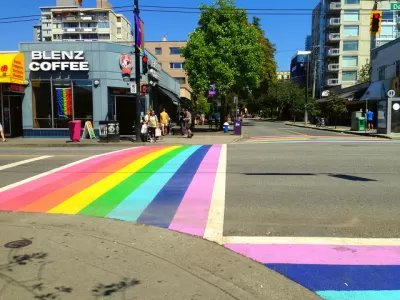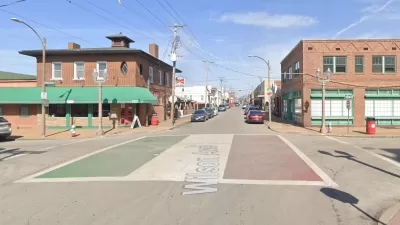As the Federal Highway Administration continues its anti-painted crosswalk crusade, attracting new attention at the national level, cities are resisting the notion that rainbow crosswalks are a safety liability.

In recent years, the Federal Highway Administration has targeted rainbow crosswalks as a safety risk, running afoul of federal regulations. The issue has come up in Lexington, Kentucky and, with a painted crosswalk program (not just rainbows) in St. Louis. The most recent controversy, in Ames, Iowa, attracting national media attention.
Emily S. Rueb reports:
Ahead of an annual L.G.B.T.Q. festival in Ames, Iowa, members of the City Council decided to liven up a pedestrian crosswalk near the downtown shopping district by painting stripes in colors evoking the gay, nonbinary and transgender pride flags.
Then:
But in early September, about a week after The Ames Tribune covered the cheerful ribbon-cutting ceremony, a letter arrived from the federal government: The motley intersection was a safety concern, it said, and a liability for the city.
The letter also included a request for the city to remove the crosswalk. The Ames City Council voted unanimously to ignore that request.
Just the idea of such a request prompted a response in Atlanta, according to an article by Stephen Deere. "The federal government has not asked the city of Atlanta to remove the rainbow crosswalks at 10th Street and Piedmont Avenue, but even if it did, the city wouldn’t comply, said a spokesman for Mayor Keisha Lance Bottoms."
In response to the continued anti-painted crosswalk actions of the Federal Highway Administration, former Streetsblog Editor Angie Schmitt took to Twitter to call out the hypocrisy of traffic safety policy in the United States.
Literally U.S. DOT: The thing on the left is fine and acceptable. The thing on the right is a safety hazard. pic.twitter.com/RapqffOR2p
— Angie Schmitt (@schmangee) October 7, 2019
FULL STORY: The Government Says Rainbow Crosswalks Could Be Unsafe. Are They Really?

Study: Maui’s Plan to Convert Vacation Rentals to Long-Term Housing Could Cause Nearly $1 Billion Economic Loss
The plan would reduce visitor accommodation by 25,% resulting in 1,900 jobs lost.

North Texas Transit Leaders Tout Benefits of TOD for Growing Region
At a summit focused on transit-oriented development, policymakers discussed how North Texas’ expanded light rail system can serve as a tool for economic growth.

Why Should We Subsidize Public Transportation?
Many public transit agencies face financial stress due to rising costs, declining fare revenue, and declining subsidies. Transit advocates must provide a strong business case for increasing public transit funding.

How to Make US Trains Faster
Changes to boarding platforms and a switch to electric trains could improve U.S. passenger rail service without the added cost of high-speed rail.

Columbia’s Revitalized ‘Loop’ Is a Hub for Local Entrepreneurs
A focus on small businesses is helping a commercial corridor in Columbia, Missouri thrive.

Invasive Insect Threatens Minnesota’s Ash Forests
The Emerald Ash Borer is a rapidly spreading invasive pest threatening Minnesota’s ash trees, and homeowners are encouraged to plant diverse replacement species, avoid moving ash firewood, and monitor for signs of infestation.
Urban Design for Planners 1: Software Tools
This six-course series explores essential urban design concepts using open source software and equips planners with the tools they need to participate fully in the urban design process.
Planning for Universal Design
Learn the tools for implementing Universal Design in planning regulations.
City of Santa Clarita
Ascent Environmental
Institute for Housing and Urban Development Studies (IHS)
City of Grandview
Harvard GSD Executive Education
Toledo-Lucas County Plan Commissions
Salt Lake City
NYU Wagner Graduate School of Public Service





























